Mission accomplished again! Now do more.
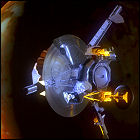 Completing its extended two-year tour of Jupiter and its intriguing moons Io and Europa, NASA’s Galileo robotic probe is given another extension, this time called the Galileo Millennium Mission. Highlights are expected to include observing Jupiter in tandem with the Cassini unmanned probe, which will swing by Jupiter in 2000 to gain a gravity assist en route to its own final target, Saturn. Galileo will also resume its exploration of the major Jovian moon Ganymede, the solar system’s largest satellite.
Completing its extended two-year tour of Jupiter and its intriguing moons Io and Europa, NASA’s Galileo robotic probe is given another extension, this time called the Galileo Millennium Mission. Highlights are expected to include observing Jupiter in tandem with the Cassini unmanned probe, which will swing by Jupiter in 2000 to gain a gravity assist en route to its own final target, Saturn. Galileo will also resume its exploration of the major Jovian moon Ganymede, the solar system’s largest satellite.
STS-103: return to Hubble
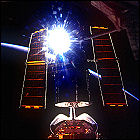 Space Shuttle Discovery lifts off on an eight-day mission to retrieve, service and redeploy the Hubble Space Telescope. This routine planned upgrade for Hubble sees the shuttle crew swapping out the $2,000,000,000 telescope’s CPU, installing a new one with 20 times the processing power of the original, during an eight-hour spacewalk; another eight-hour spacewalk sees crewmembers removing an analog data recorder to replace it with a digital device with greater capacity. Christmas 1999 is spent placing Hubble back into its orbit. Aboard Discovery for her 27th flight are Commander Curtis Brown, Pilot Scott Kelly, and mission specialists Steven Smith, Michael Foale, John Grunsfield, Claude Nicollier and Jean-Francois Clervoy.
Space Shuttle Discovery lifts off on an eight-day mission to retrieve, service and redeploy the Hubble Space Telescope. This routine planned upgrade for Hubble sees the shuttle crew swapping out the $2,000,000,000 telescope’s CPU, installing a new one with 20 times the processing power of the original, during an eight-hour spacewalk; another eight-hour spacewalk sees crewmembers removing an analog data recorder to replace it with a digital device with greater capacity. Christmas 1999 is spent placing Hubble back into its orbit. Aboard Discovery for her 27th flight are Commander Curtis Brown, Pilot Scott Kelly, and mission specialists Steven Smith, Michael Foale, John Grunsfield, Claude Nicollier and Jean-Francois Clervoy.
Galileo vs. the Volcano
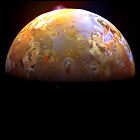 NASA/JPL’s unmanned Galileo space probe buzzes Jupiter’s volcanically active moon Io, zipping directly over one of its most active volcanic regions at an altitude of only 380 miles, Galileo’s closest Io flyby to date. But this close encounter, and the fate of Galileo itself, had been in doubt just hours before the flyby: entering Jupiter’s most intense radiation environment, Galileo had entered a failsafe mode in which the spacecraft shuts down until further commands are received from Earth. Ground controllers, called in to work emergency hours on a Sunday, revive Galileo a mere two hours before its close pass by Io.
NASA/JPL’s unmanned Galileo space probe buzzes Jupiter’s volcanically active moon Io, zipping directly over one of its most active volcanic regions at an altitude of only 380 miles, Galileo’s closest Io flyby to date. But this close encounter, and the fate of Galileo itself, had been in doubt just hours before the flyby: entering Jupiter’s most intense radiation environment, Galileo had entered a failsafe mode in which the spacecraft shuts down until further commands are received from Earth. Ground controllers, called in to work emergency hours on a Sunday, revive Galileo a mere two hours before its close pass by Io.
Galileo and the battery acid of Europa
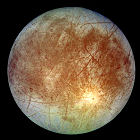 A long-standing mystery of one of the moons of Jupiter is solved, opening many more questions. Data gathered by the Galileo unmanned orbiter reveals that a previously unidentifiable substance on Europa’s surface is sulfuric acid, a compound used as battery acid on Earth. Scientists quickly split into two camps on the origins of the acid: it may be welling up from inside Europa, or it may be volcanic material ejected from Io and then deposited on Europa as the moons’ orbits occasionally bring them into conjunction. Though the presence of sulfuric acid initially dashes hopes of finding life on Europa, the possibility is not completely ruled out by this finding.
A long-standing mystery of one of the moons of Jupiter is solved, opening many more questions. Data gathered by the Galileo unmanned orbiter reveals that a previously unidentifiable substance on Europa’s surface is sulfuric acid, a compound used as battery acid on Earth. Scientists quickly split into two camps on the origins of the acid: it may be welling up from inside Europa, or it may be volcanic material ejected from Io and then deposited on Europa as the moons’ orbits occasionally bring them into conjunction. Though the presence of sulfuric acid initially dashes hopes of finding life on Europa, the possibility is not completely ruled out by this finding.
Galileo and the strange chemistry of Europa
 NASA scientists announce a startling find on one of Jupiter’s moons: a chemical which must be manufactured on Earth occurs naturally on the surface of Europa. The Galileo orbiter detects naturally-occurring hydrogren peroxide on the surface of the icy moon (a surface which most planetary scientists now believe covers an ocean of water or “slush” just beneath the crust), probably caused by the constant bombardment of radiation-charged particles from Jupiter itself. The hydrogen peroxide on Europa is also found to be very short-lived, quickly breaking down into gaseous oxygen and hydrogen.
NASA scientists announce a startling find on one of Jupiter’s moons: a chemical which must be manufactured on Earth occurs naturally on the surface of Europa. The Galileo orbiter detects naturally-occurring hydrogren peroxide on the surface of the icy moon (a surface which most planetary scientists now believe covers an ocean of water or “slush” just beneath the crust), probably caused by the constant bombardment of radiation-charged particles from Jupiter itself. The hydrogen peroxide on Europa is also found to be very short-lived, quickly breaking down into gaseous oxygen and hydrogen.
Galileo and the atmosphere of Callisto
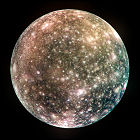 NASA reveals recent findings from the unmanned Galileo orbiter touring Jupiter and its moons, including the discovery of a tenuous atmosphere surrounding the outermost large moon of Jupiter, Callisto. The thin layer of carbon dioxide surrounding Callisto completes the set: Galileo has detected an atmosphere of one kind or another around each of Jupiter’s four Galilean moons, some of which are large enough to be planets. As for how the atmosphere is sustained in the extremely hostile environment around Jupiter, scientists speculate that the CO2 could be emitted from beneath Callisto’s own crust.
NASA reveals recent findings from the unmanned Galileo orbiter touring Jupiter and its moons, including the discovery of a tenuous atmosphere surrounding the outermost large moon of Jupiter, Callisto. The thin layer of carbon dioxide surrounding Callisto completes the set: Galileo has detected an atmosphere of one kind or another around each of Jupiter’s four Galilean moons, some of which are large enough to be planets. As for how the atmosphere is sustained in the extremely hostile environment around Jupiter, scientists speculate that the CO2 could be emitted from beneath Callisto’s own crust.
NEAR death experience?
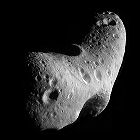 NASA’s unmanned NEAR (Near Earth Asteroid Rendezvous) unmanned space probe fails to fire its thrusters for a critical engine burn to keep it aimed at asteroid 433 Eros. The vehicle instead goes into an automatic safe mode and enters a tumble that drains both its batteries and its fuel supply to dangerously low levels, and it is out of contact with Earth for over a day. As a result, NEAR merely flies past Eros at a distance of almost 2400 miles, leaving ground controllers to devise a strategy to re-aim NEAR so it can catch up to and try once again to orbit the asteroid (the primary objective of its mission). This maneuver will take a year to complete.
NASA’s unmanned NEAR (Near Earth Asteroid Rendezvous) unmanned space probe fails to fire its thrusters for a critical engine burn to keep it aimed at asteroid 433 Eros. The vehicle instead goes into an automatic safe mode and enters a tumble that drains both its batteries and its fuel supply to dangerously low levels, and it is out of contact with Earth for over a day. As a result, NEAR merely flies past Eros at a distance of almost 2400 miles, leaving ground controllers to devise a strategy to re-aim NEAR so it can catch up to and try once again to orbit the asteroid (the primary objective of its mission). This maneuver will take a year to complete.
Voyager 2’s silent scare
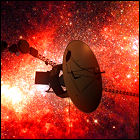 NASA’s Voyager 2 spacecraft, nearly ten years after its final planetary encounter, suddenly goes quiet. For 66 hours, the space probe returns no signal or telemetry data to Earth, while engineers on the ground send 720 commands to Voyager 2 to begin transmitting again. When Voyager 2 does re-establish communications with Earth, it has switched to a backup transmitter, and the temperature of some on-board components is warmer than expected. The spacecraft has not gone into a safe mode, but reports receiving only 19 of the 720 commands to transmit. At nearly six billion miles from Earth, Voyager 2 is heading for the edge of the solar system at 35,000 miles per hour, and is expected to remain functional into the 2020s, provided the spacecraft experiences no further major faults.
NASA’s Voyager 2 spacecraft, nearly ten years after its final planetary encounter, suddenly goes quiet. For 66 hours, the space probe returns no signal or telemetry data to Earth, while engineers on the ground send 720 commands to Voyager 2 to begin transmitting again. When Voyager 2 does re-establish communications with Earth, it has switched to a backup transmitter, and the temperature of some on-board components is warmer than expected. The spacecraft has not gone into a safe mode, but reports receiving only 19 of the 720 commands to transmit. At nearly six billion miles from Earth, Voyager 2 is heading for the edge of the solar system at 35,000 miles per hour, and is expected to remain functional into the 2020s, provided the spacecraft experiences no further major faults.
Galileo and the oceans of Callisto
 The unmanned NASA/JPL space probe Galileo makes a remarkable find at Callisto, the outermost of Jupiter’s four large “Galilean” moons: evidence that a saltwater ocean may lie beneath the moon’s pockmarked surface. Even more unusually, it may be the catalyst for Callisto’s magnetic field (a rarity for a satellite – not even all of the solar system’s planets have magnetic fields). Galileo’s instruments raise the possibility that the subsurface ocean may be conducting electricity and helping to generate that field (which current scientific models say Callisto should be too small to generate on its own). Scientists do not, however, believe that Callisto is a strong candidate to support life, unlike Europa.
The unmanned NASA/JPL space probe Galileo makes a remarkable find at Callisto, the outermost of Jupiter’s four large “Galilean” moons: evidence that a saltwater ocean may lie beneath the moon’s pockmarked surface. Even more unusually, it may be the catalyst for Callisto’s magnetic field (a rarity for a satellite – not even all of the solar system’s planets have magnetic fields). Galileo’s instruments raise the possibility that the subsurface ocean may be conducting electricity and helping to generate that field (which current scientific models say Callisto should be too small to generate on its own). Scientists do not, however, believe that Callisto is a strong candidate to support life, unlike Europa.
What Clementine found
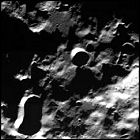 Though its extended mission was cut short by a mishap in 1994, NASA’s ill-fated Clementine lunar orbiter returned data with significant implications for further manned visits to the moon. NASA announces that craters near the north and south poles of Earth’s moon may harbor enough water ice to allow long-term colonization, and could also be used to create propellant on-site. While this promising announcement occurs as the 30th anniversary of the first manned moon landing approaches, any further manned visits exist strictly on paper.
Though its extended mission was cut short by a mishap in 1994, NASA’s ill-fated Clementine lunar orbiter returned data with significant implications for further manned visits to the moon. NASA announces that craters near the north and south poles of Earth’s moon may harbor enough water ice to allow long-term colonization, and could also be used to create propellant on-site. While this promising announcement occurs as the 30th anniversary of the first manned moon landing approaches, any further manned visits exist strictly on paper.
Voyager 1: furthest robot out
 Unmanned space prove Voyager 1, launched in 1977, surpasses its forerunner Pioneer 10 as the furthest man-made object in space. Due to a sharp increase in its speed imparted by a very close pass by Saturn’s large moon Titan in 1980, Voyager 1 has outrun Pioneer 10, which was launched in 1972. Both vehicles are still returning science data, and Voyager 1 is now 6.5 billion miles from the sun, 70 times further out from the sun than Earth. Voyager’s on-board nuclear power source is expected to keep it active through 2020.
Unmanned space prove Voyager 1, launched in 1977, surpasses its forerunner Pioneer 10 as the furthest man-made object in space. Due to a sharp increase in its speed imparted by a very close pass by Saturn’s large moon Titan in 1980, Voyager 1 has outrun Pioneer 10, which was launched in 1972. Both vehicles are still returning science data, and Voyager 1 is now 6.5 billion miles from the sun, 70 times further out from the sun than Earth. Voyager’s on-board nuclear power source is expected to keep it active through 2020.
Mission accomplished! Now keep going.
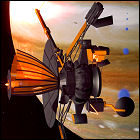 Beating the odds imposed upon it by the unforgiving environment around the planet Jupiter and its major moons, and engineering challenges such as a high-gain antenna that never unfurled properly after its 1989 launch, NASA’s Galileo space probe completes its two-year mission. Since the spacecraft is still intact and reasonably healthy, NASA gains a two-year extension, which it calls the Galileo Europa Mission, focusing on the two innermost large moons, icy Europa and volcanic Io. Trajectories are planned to fly Galileo even closer to these moons than ever before, though the harsh radiation zone around Jupiter itself could fry Galileo’s main computer and end the mission at any time.
Beating the odds imposed upon it by the unforgiving environment around the planet Jupiter and its major moons, and engineering challenges such as a high-gain antenna that never unfurled properly after its 1989 launch, NASA’s Galileo space probe completes its two-year mission. Since the spacecraft is still intact and reasonably healthy, NASA gains a two-year extension, which it calls the Galileo Europa Mission, focusing on the two innermost large moons, icy Europa and volcanic Io. Trajectories are planned to fly Galileo even closer to these moons than ever before, though the harsh radiation zone around Jupiter itself could fry Galileo’s main computer and end the mission at any time.
Cassini launched
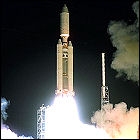 NASA/JPL’s interplanetary probe Cassini, with the European Space Agency-built Huygens Titan probe tagging along, lifts off on a Titan IV-B rocket. The voyage to Saturn will last seven years, during which Cassini does close flybys to receive gravity assists from Venus, Earth, Earth’s moon, and Jupiter en route to Saturn. It will operate in Saturn’s vicinity for over a decade and launch the Huygens probe, the first landing probe to visit a body in the outer solar system.
NASA/JPL’s interplanetary probe Cassini, with the European Space Agency-built Huygens Titan probe tagging along, lifts off on a Titan IV-B rocket. The voyage to Saturn will last seven years, during which Cassini does close flybys to receive gravity assists from Venus, Earth, Earth’s moon, and Jupiter en route to Saturn. It will operate in Saturn’s vicinity for over a decade and launch the Huygens probe, the first landing probe to visit a body in the outer solar system.
Pathfinder falls silent
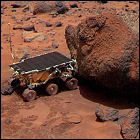 Its ability to recharge its power supply depleted, the Mars Pathfinder lander – now dubbed Sagan Memorial Station – ceases its transmissions to Earth, also cutting off communication with the Sojourner Mars rover. Originally intended for a month-long mission, Pathfinder and Sojourner last three times that long, and give scientists and engineers a wealth of data for planning the twin Mars Exploration Rovers. NASA declares the Pathfinder mission a complete success in early 1998.
Its ability to recharge its power supply depleted, the Mars Pathfinder lander – now dubbed Sagan Memorial Station – ceases its transmissions to Earth, also cutting off communication with the Sojourner Mars rover. Originally intended for a month-long mission, Pathfinder and Sojourner last three times that long, and give scientists and engineers a wealth of data for planning the twin Mars Exploration Rovers. NASA declares the Pathfinder mission a complete success in early 1998.
Red planet rover, please come over
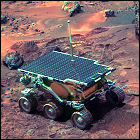 Sojourner, the original Mars rover, rides out on the Martian surface, getting close-up looks at nearby rocks and demonstrating technologies that are vital to upcoming Mars missions, including automatic hazard detection and avoidance. Sojourner’s ability to “see” obstacles and navigate around them without advice from ground controllers will be essential to later Mars rovers, since it takes seven minutes for a signal to reach Earth, and seven more minutes for instructions to return. The rover captures the public imagination and is even immortalized as a Hot Wheels toy.
Sojourner, the original Mars rover, rides out on the Martian surface, getting close-up looks at nearby rocks and demonstrating technologies that are vital to upcoming Mars missions, including automatic hazard detection and avoidance. Sojourner’s ability to “see” obstacles and navigate around them without advice from ground controllers will be essential to later Mars rovers, since it takes seven minutes for a signal to reach Earth, and seven more minutes for instructions to return. The rover captures the public imagination and is even immortalized as a Hot Wheels toy.
Pathfinder bounces onto Mars
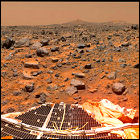 Using a never-before-attempted system of landing, the Mars Pathfinder unmanned probe employs an aerobraking maneuver to slow down in the planet’s atmosphere, and an all-encompassing layer of airbags to “bounce” onto the surface without using rockets to slow the vehicle down. The weighted landing station rolls to the correct orientation, deflates the airbags, and deploys on schedule, proving the merits of a landing technique that will deliver future Mars landers already in the planning stages.
Using a never-before-attempted system of landing, the Mars Pathfinder unmanned probe employs an aerobraking maneuver to slow down in the planet’s atmosphere, and an all-encompassing layer of airbags to “bounce” onto the surface without using rockets to slow the vehicle down. The weighted landing station rolls to the correct orientation, deflates the airbags, and deploys on schedule, proving the merits of a landing technique that will deliver future Mars landers already in the planning stages.
NEAR at Mathilde
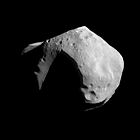 NASA’s NEAR (Near Earth Asteroid Rendezvous) unmanned spacecraft closes to within 750 miles of its first target, asteroid 253 Mathilde. Taking over 500 pictures of the asteroid and determining its mass and dimensions (roughly 31 miles in diameter). At the time of this flyby, Mathilde is the largest asteroid to be explored by a spacecraft. Discovered in 1885, Mathilde takes four years to orbit the sun within the main asteroid belt between Mars and Jupiter. NEAR Shoemaker moves on to its next destination, asteroid 433 Eros, which it is expected to reach in 1998.
NASA’s NEAR (Near Earth Asteroid Rendezvous) unmanned spacecraft closes to within 750 miles of its first target, asteroid 253 Mathilde. Taking over 500 pictures of the asteroid and determining its mass and dimensions (roughly 31 miles in diameter). At the time of this flyby, Mathilde is the largest asteroid to be explored by a spacecraft. Discovered in 1885, Mathilde takes four years to orbit the sun within the main asteroid belt between Mars and Jupiter. NEAR Shoemaker moves on to its next destination, asteroid 433 Eros, which it is expected to reach in 1998.
Pathfinder bounces into toy stores
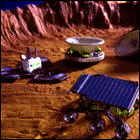 American toy company Mattel releases a Mars Pathfinder playset as part of its venerable Hot Wheels range of toy cars. The set includes miniature replicas of Pathfinder’s atmospheric entry capsule (complete with removable backshell) and the three-petaled Pathfinder landing station, but the highlight is the intricately (and very accurately) detailed miniature Sojourner Mars rover. Mattel has licensed the patented designs of the spacecraft through JPL’s Technology Affiliates program.
American toy company Mattel releases a Mars Pathfinder playset as part of its venerable Hot Wheels range of toy cars. The set includes miniature replicas of Pathfinder’s atmospheric entry capsule (complete with removable backshell) and the three-petaled Pathfinder landing station, but the highlight is the intricately (and very accurately) detailed miniature Sojourner Mars rover. Mattel has licensed the patented designs of the spacecraft through JPL’s Technology Affiliates program.
GOES-10 lifts off
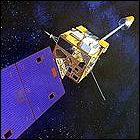 NOAA’s GOES-10 Geostationary Operational Environmental Satellite is launched from Cape Canaveral into a geosynchronous orbit to monitor weather patterns over the United States. GOES-10 suffers significant hardware issues upon reaching orbit, including the failure of sun-tracking sensors to orient its solar panels, and it will be over a year before it is pressed into operational service in the GOES-WEST orbit by the failure of GOES-9’s attitude control system. GOES-10 will operate there until 2006, when, upon the launch of GOES-11, it takes up a new position, GOES-SOUTH, monitoring South America and watching for Atlantic Ocean hurricane and tropical storm formation. It will be briefly moved back into the GOES-EAST orbit in late 2007, and with just enough maneuvering fuel left to boost it, it will finally be retired to the above-geostationary “graveyard” orbit in 2009.
NOAA’s GOES-10 Geostationary Operational Environmental Satellite is launched from Cape Canaveral into a geosynchronous orbit to monitor weather patterns over the United States. GOES-10 suffers significant hardware issues upon reaching orbit, including the failure of sun-tracking sensors to orient its solar panels, and it will be over a year before it is pressed into operational service in the GOES-WEST orbit by the failure of GOES-9’s attitude control system. GOES-10 will operate there until 2006, when, upon the launch of GOES-11, it takes up a new position, GOES-SOUTH, monitoring South America and watching for Atlantic Ocean hurricane and tropical storm formation. It will be briefly moved back into the GOES-EAST orbit in late 2007, and with just enough maneuvering fuel left to boost it, it will finally be retired to the above-geostationary “graveyard” orbit in 2009.
STS-82: back to Hubble
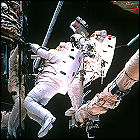 Space Shuttle Discovery lifts off on a ten-day mission to service the Hubble Space Telescope. Over 30 hours of spacewalks are conducted to repair and upgrade Hubble with new parts, and the shuttle engines are fired in short, steady bursts to raise the telescope’s orbit by over eight miles before it is released again. Aboard Discovery on her 22nd flight are Commander Kenneth Bowersox, Pilot Scott Horowitz, and mission specialists Mark Lee, Steven Hawley, Gregory Harbaugh, Steven Smith and Joseph Tanner.
Space Shuttle Discovery lifts off on a ten-day mission to service the Hubble Space Telescope. Over 30 hours of spacewalks are conducted to repair and upgrade Hubble with new parts, and the shuttle engines are fired in short, steady bursts to raise the telescope’s orbit by over eight miles before it is released again. Aboard Discovery on her 22nd flight are Commander Kenneth Bowersox, Pilot Scott Horowitz, and mission specialists Mark Lee, Steven Hawley, Gregory Harbaugh, Steven Smith and Joseph Tanner.
Hubble spots “space tornadoes”
 NASA’s Hubble Space Telescope does some interstellar storm spotting, capturing an image of funnel-cloud-shaped structures in the Lagoon Nebula, 5,000 light years away from Earth. Similar to the star-forming structures in the Eagle Nebula, the Lagoon Nebula’s star-birthing clouds are seen to be twisting into tornado-like shapes, possibly due to interactions of gases with extreme hot and cold temperatures, not unlike the weather processes leading to tornado formation on Earth.
NASA’s Hubble Space Telescope does some interstellar storm spotting, capturing an image of funnel-cloud-shaped structures in the Lagoon Nebula, 5,000 light years away from Earth. Similar to the star-forming structures in the Eagle Nebula, the Lagoon Nebula’s star-birthing clouds are seen to be twisting into tornado-like shapes, possibly due to interactions of gases with extreme hot and cold temperatures, not unlike the weather processes leading to tornado formation on Earth.
Pathfinder en route to Mars
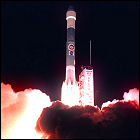 NASA/JPL’s low-cost Mars Pathfinder mission lifts off for a date with Mars. The first American Mars lander since the Viking missions of the 1970s, Pathfinder is practically an interplanetary tech demonstration, showing off new landing techniques (aerobraking and landing airbags), new lander designs (a fixed station delivering a wheeled “rover”), and the beginning of a new commitment to exploring Mars. By the time operations are wrapped up on the Pathfinder mission, the total amount of money spent is under $300,000,000.
NASA/JPL’s low-cost Mars Pathfinder mission lifts off for a date with Mars. The first American Mars lander since the Viking missions of the 1970s, Pathfinder is practically an interplanetary tech demonstration, showing off new landing techniques (aerobraking and landing airbags), new lander designs (a fixed station delivering a wheeled “rover”), and the beginning of a new commitment to exploring Mars. By the time operations are wrapped up on the Pathfinder mission, the total amount of money spent is under $300,000,000.
International Ultraviolet Explorer shuts down
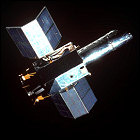 Launched in 1978 as a joint venture between NASA and ESA, the unmanned International Ultraviolet Explorer is commanded to exhaust its remaining fuel and cease all contact with Earth. Though its detectors and other instruments are still functioning well after 18 years in orbit, its stabilization gyros have failed one by one until the satellite is unable to be aimed at deep space targets with any accuracy. IUE remains powered down, adrift in a geosynchronous orbit.
Launched in 1978 as a joint venture between NASA and ESA, the unmanned International Ultraviolet Explorer is commanded to exhaust its remaining fuel and cease all contact with Earth. Though its detectors and other instruments are still functioning well after 18 years in orbit, its stabilization gyros have failed one by one until the satellite is unable to be aimed at deep space targets with any accuracy. IUE remains powered down, adrift in a geosynchronous orbit.
All aboard the Pluto-Kuiper Express
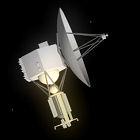 With NASA/JPL’s Pluto Fast Flyby mission cancelled, a new mission is proposed by several scientists and engineers, including veterans of the Voyager program, to send a small spacecraft to Pluto. Originally named Pluto Express, and later Pluto-Kuiper Express, the unmanned spacecraft would be armed with a handful of scientific instruments (as opposed to Pluto Fast Flyby’s camera-only proposal). Plans call for launch via a Delta Heavy rocket or from the cargo bay of a Space Shuttle in 2004, a Jupiter gravity assist flyby in 2006, and a Pluto flyby in 2012. Though there are early talks with the Russian space program about including landers or penetrators, that element of the mission is dropped soon afterward.
With NASA/JPL’s Pluto Fast Flyby mission cancelled, a new mission is proposed by several scientists and engineers, including veterans of the Voyager program, to send a small spacecraft to Pluto. Originally named Pluto Express, and later Pluto-Kuiper Express, the unmanned spacecraft would be armed with a handful of scientific instruments (as opposed to Pluto Fast Flyby’s camera-only proposal). Plans call for launch via a Delta Heavy rocket or from the cargo bay of a Space Shuttle in 2004, a Jupiter gravity assist flyby in 2006, and a Pluto flyby in 2012. Though there are early talks with the Russian space program about including landers or penetrators, that element of the mission is dropped soon afterward.
Hubble peeks at Pluto
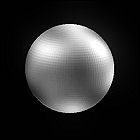 After decades of the tiny object being seen only as a point of light in even the best telescopic images, the Hubble Space Telescope makes the first survey of the surface of Pluto. Even without the distortion introduced by Earth’s atmosphere, Hubble’s best shots of Pluto are vague due to the distance from Earth to Pluto, but they mark the first time that even blurry surface detail has been seen. The new images help NASA gain support for a Pluto flyby mission in the 21st century, which will eventually be named New Horizons.
After decades of the tiny object being seen only as a point of light in even the best telescopic images, the Hubble Space Telescope makes the first survey of the surface of Pluto. Even without the distortion introduced by Earth’s atmosphere, Hubble’s best shots of Pluto are vague due to the distance from Earth to Pluto, but they mark the first time that even blurry surface detail has been seen. The new images help NASA gain support for a Pluto flyby mission in the 21st century, which will eventually be named New Horizons.
NEAR launched
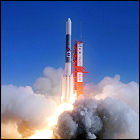 The NEAR (Near Earth Asteroid Rendezvous) unmanned spacecraft, built and flown for NASA by John Hopkins University’s Applied Physics Lab, lifts off from Cape Canaveral on a mission to orbit and study asteroid 433 Eros, a target it won’t reach until 1998 at the earliest; it will fly by another asteroid in 1997. Other trajectories under consideration during mission planning included a combination of several asteroids and comets, before the limitations of NEAR’s chemical propulsion system forced those plans to be scaled back. (A more ambitious multi-asteroid mission, Dawn, will be launched in the 21st century.) NEAR will become the first human-made spacecraft to land on an asteroid.
The NEAR (Near Earth Asteroid Rendezvous) unmanned spacecraft, built and flown for NASA by John Hopkins University’s Applied Physics Lab, lifts off from Cape Canaveral on a mission to orbit and study asteroid 433 Eros, a target it won’t reach until 1998 at the earliest; it will fly by another asteroid in 1997. Other trajectories under consideration during mission planning included a combination of several asteroids and comets, before the limitations of NEAR’s chemical propulsion system forced those plans to be scaled back. (A more ambitious multi-asteroid mission, Dawn, will be launched in the 21st century.) NEAR will become the first human-made spacecraft to land on an asteroid.
Galileo takes the plunge
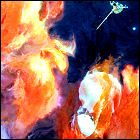 After five months of independent flight, the Galileo atmospheric probe slams into the atmosphere of giant planet Jupiter at a speed over 100,000mph, burrowing over a hundred miles into the huge planet’s dense atmosphere before the heat of entry and the atmospheric pressure crush the probe. Deploying a parachute to slow its descent, the probe survives for nearly an hour, its sensors finding a surprisingly dry atmosphere. As it plummets toward the center of Jupiter, the Galileo probe registers 450mph winds, but never finds any hints of anything resembling a solid surface. The sum total of the probe’s sensor readings – the entirety of our data gathered directly within the atmosphere of Jupiter – tops out at 460 kilobytes of data.
After five months of independent flight, the Galileo atmospheric probe slams into the atmosphere of giant planet Jupiter at a speed over 100,000mph, burrowing over a hundred miles into the huge planet’s dense atmosphere before the heat of entry and the atmospheric pressure crush the probe. Deploying a parachute to slow its descent, the probe survives for nearly an hour, its sensors finding a surprisingly dry atmosphere. As it plummets toward the center of Jupiter, the Galileo probe registers 450mph winds, but never finds any hints of anything resembling a solid surface. The sum total of the probe’s sensor readings – the entirety of our data gathered directly within the atmosphere of Jupiter – tops out at 460 kilobytes of data.
Hubble’s “pillars of creation”
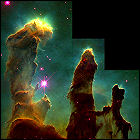 The Hubble Space Telescope, observing M16 (also known as the Eagle Nebula), takes what may be its most famous image: towering clouds of rapidly-evaporating interstellar gas which scientists theorize are the birthplace of new stars. The huge, light-years-long hydrogen clouds are dubbed evaporating gaseous globules, or EGGs; astronomers also call the structure a stellar nursery. The image quickly becomes a mainstay of the media, making appearances in Babylon 5 and the movie Contact.
The Hubble Space Telescope, observing M16 (also known as the Eagle Nebula), takes what may be its most famous image: towering clouds of rapidly-evaporating interstellar gas which scientists theorize are the birthplace of new stars. The huge, light-years-long hydrogen clouds are dubbed evaporating gaseous globules, or EGGs; astronomers also call the structure a stellar nursery. The image quickly becomes a mainstay of the media, making appearances in Babylon 5 and the movie Contact.
GOES-9 goes up
 NOAA’s GOES-9 Geostationary Operational Environmental Satellite is launched from Cape Canaveral into a geosynchronous orbit now designated GOES-EAST to monitor weather patterns over the United States; its predecessor, GOES-8, remains in orbit in the GOES-WEST position. GOES-9’s hardware configuration is identical to that of GOES-8, and both suffer minor glitches which will be corrected prior to launch in the GOES-10 satellite. GOES-9 will remain in the GOES-EAST orbit until it is retired from active weather-watching duty in 1998 due to those hardware problems, though it will be pressed back into served and leased to Japan to replace one of that country’s weather satellites between 2003 and 2005. GOES-9 will finally be retired in 2007.
NOAA’s GOES-9 Geostationary Operational Environmental Satellite is launched from Cape Canaveral into a geosynchronous orbit now designated GOES-EAST to monitor weather patterns over the United States; its predecessor, GOES-8, remains in orbit in the GOES-WEST position. GOES-9’s hardware configuration is identical to that of GOES-8, and both suffer minor glitches which will be corrected prior to launch in the GOES-10 satellite. GOES-9 will remain in the GOES-EAST orbit until it is retired from active weather-watching duty in 1998 due to those hardware problems, though it will be pressed back into served and leased to Japan to replace one of that country’s weather satellites between 2003 and 2005. GOES-9 will finally be retired in 2007.
Farewell, Magellan!
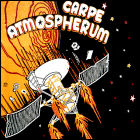 NASA’s Magellan space probe, orbiting Venus since 1990, is retired by entering the atmosphere of the planet whose surface it has mapped. With its power systems exhibiting signs of age and wear, Magellan has been intentionally dropped into an orbit low enough to allow its destruction in Venus’ dense atmosphere. Launched in 1989 via space shuttle, Magellan mapped the planet’s surface with cloud-penetrating radar, covering 98% of the Venusian surface, at least 1/5 of it with stereoscopic imaging allowing for accurate 3-D reconstruction of Venus’ surface features.
NASA’s Magellan space probe, orbiting Venus since 1990, is retired by entering the atmosphere of the planet whose surface it has mapped. With its power systems exhibiting signs of age and wear, Magellan has been intentionally dropped into an orbit low enough to allow its destruction in Venus’ dense atmosphere. Launched in 1989 via space shuttle, Magellan mapped the planet’s surface with cloud-penetrating radar, covering 98% of the Venusian surface, at least 1/5 of it with stereoscopic imaging allowing for accurate 3-D reconstruction of Venus’ surface features.